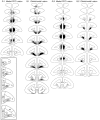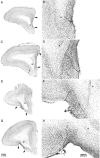Lesions of the orbitofrontal but not medial prefrontal cortex disrupt conditioned reinforcement in primates
- PMID: 14657178
- PMCID: PMC6741044
- DOI: 10.1523/JNEUROSCI.23-35-11189.2003
Lesions of the orbitofrontal but not medial prefrontal cortex disrupt conditioned reinforcement in primates
Abstract
The ventromedial prefrontal cortex (PFC) is implicated in affective and motivated behaviors. Damage to this region, which includes the orbitofrontal cortex as well as ventral sectors of medial PFC, causes profound changes in emotional and social behavior, including impairments in certain aspects of decision making. One reinforcement mechanism that may well contribute to these behaviors is conditioned reinforcement, whereby previously neutral stimuli in the environment, by virtue of their association with primary rewards, take on reinforcing value and come to support instrumental action. Conditioned reinforcers are powerful determinants of behavior and can maintain responding over protracted periods of time in the absence of and potentially in conflict with primary reinforcers. It has already been shown that conditioned reinforcement is dependent on the amygdala, and because the amygdala projects to both the orbitofrontal cortex and the medial PFC, the present study determined whether conditioned reinforcement was also dependent on one or the other of these prefrontal regions. Comparison of the behavioral effects of selective excitotoxic lesions of the PFC in the common marmoset revealed that orbitofrontal but not medial PFC lesions disrupted two distinct measures of conditioned reinforcement: (1) acquisition of a new response and (2) sensitivity to conditioned stimulus omission on a second-order schedule. In contrast, the orbitofrontal lesion did not affect sensitivity to primary reinforcement as measured by responding on a progressive-ratio schedule and a home cage consumption test. Together, these findings demonstrate the critical and specific involvement of the orbitofrontal cortex but not the medial PFC in conditioned reinforcement.
Figures






Similar articles
-
The role of the primate amygdala in conditioned reinforcement.J Neurosci. 2001 Oct 1;21(19):7770-80. doi: 10.1523/JNEUROSCI.21-19-07770.2001. J Neurosci. 2001. PMID: 11567067 Free PMC article.
-
The role of the orbitofrontal cortex in the pursuit of happiness and more specific rewards.Nature. 2008 Jul 17;454(7202):340-4. doi: 10.1038/nature06993. Epub 2008 Jun 18. Nature. 2008. PMID: 18563088 Free PMC article.
-
Lesions of ventrolateral prefrontal or anterior orbitofrontal cortex in primates heighten negative emotion.Biol Psychiatry. 2012 Aug 15;72(4):266-72. doi: 10.1016/j.biopsych.2012.03.007. Epub 2012 Apr 12. Biol Psychiatry. 2012. PMID: 22502990
-
The functions of the orbitofrontal cortex.Brain Cogn. 2004 Jun;55(1):11-29. doi: 10.1016/S0278-2626(03)00277-X. Brain Cogn. 2004. PMID: 15134840 Review.
-
The orbitofrontal cortex and emotion in health and disease, including depression.Neuropsychologia. 2019 May;128:14-43. doi: 10.1016/j.neuropsychologia.2017.09.021. Epub 2017 Sep 24. Neuropsychologia. 2019. PMID: 28951164 Review.
Cited by
-
The pharmacological stressor yohimbine, but not U50,488, increases responding for conditioned reinforcers paired with ethanol or sucrose.Psychopharmacology (Berl). 2020 Dec;237(12):3689-3702. doi: 10.1007/s00213-020-05647-0. Epub 2020 Aug 25. Psychopharmacology (Berl). 2020. PMID: 32840668
-
Aberrations in Incentive Learning and Responding to Heroin in Male Rats After Adolescent or Adult Chronic Binge-Like Alcohol Exposure.Alcohol Clin Exp Res. 2020 Jun;44(6):1214-1223. doi: 10.1111/acer.14341. Epub 2020 May 14. Alcohol Clin Exp Res. 2020. PMID: 32311102 Free PMC article.
-
Orbitofrontal cortex, associative learning, and expectancies.Neuron. 2005 Sep 1;47(5):633-6. doi: 10.1016/j.neuron.2005.07.018. Neuron. 2005. PMID: 16129393 Free PMC article. Review.
-
Direct interactions between the basolateral amygdala and nucleus accumbens core underlie cocaine-seeking behavior by rats.J Neurosci. 2004 Aug 11;24(32):7167-73. doi: 10.1523/JNEUROSCI.1581-04.2004. J Neurosci. 2004. PMID: 15306650 Free PMC article.
-
Dissociable contributions of the human amygdala and orbitofrontal cortex to incentive motivation and goal selection.J Neurosci. 2003 Oct 22;23(29):9632-8. doi: 10.1523/JNEUROSCI.23-29-09632.2003. J Neurosci. 2003. PMID: 14573543 Free PMC article. Clinical Trial.
References
-
- Amaral DG, Price JL, Pitakanen A, Carmichael ST ( 1992) Anatomical organization of the primate amygdaloid complex. In: The amygdala (Aggleton JP, ed), pp 1-66. New York: Wiley-Liss.
-
- Arroyo M, Markou A, Robbins TW, Everitt BJ ( 1998) Acquisition, maintenance and reinstatement of intravenous cocaine self-administration under a second-order schedule of reinforcement in rats: effects of conditioned cues and continuous access to cocaine. Psychopharmacology (Berl) 140: 331-344. - PubMed
-
- Balleine BW, Dickinson A ( 1998) Goal-directed instrumental action: contingency and incentive learning and their cortical substrates. Neuropharmacology 37: 407-419. - PubMed
Publication types
MeSH terms
Substances
Grants and funding
LinkOut - more resources
Full Text Sources
Miscellaneous
